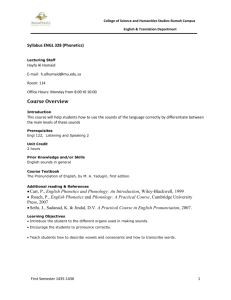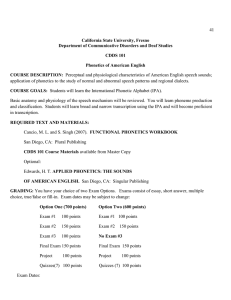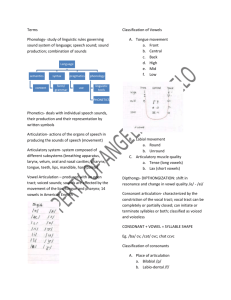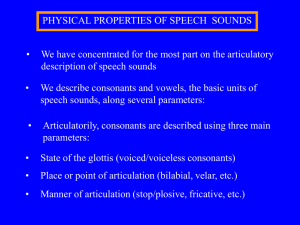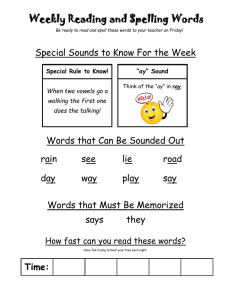Chapter 1 : Introduction
advertisement
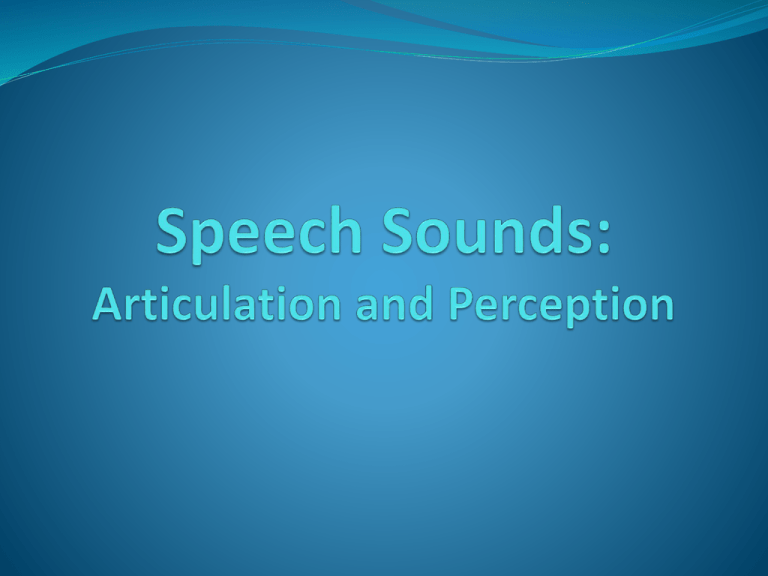
Phonology Phonology is the branch of linguistics which investigates the ways in which sounds are used systematically in different languages to form words and utterances. In order to understand phonology, one must have a grasp of the basic concepts of PHONETICS, the study of the inventory of all SPEECH SOUNDS which humans are capable of producing Introduction Speech is produced and heard normally as a continuous stream of sounds. How speech sounds are produced and perceived is described in Phonetics. Phonetics is the scientific study of speech sounds. It consists of three main sub-fields: Articulatory phonetics: the study of the production of speech sounds by the articulatory and vocal tract by the speaker. Acoustic phonetics: the study of the physical transmission of speech sounds from the speaker to the listener. Auditory Phonetics: the study of the reception and perception of speech sounds by the listener. This part is concerned mainly with the production of speech sounds described in terms of articulatory and acoustic phonetics. Articulation of speech sounds is the second stage of speech production. Once we have organized our thoughts into a linguistic plan, this information must be sent from the brain to the articulatory organs in the speech system so that they can then execute the required movements and produce the desired sounds. Articulatory Organs Using the articulatory organs in the mouth and throat, speakers produce various speech sounds by modifying the flow of air expelled from the lungs. The air flow is first modified in the throat, at larynx which contains the vocal cords. The vocal cords folds come together and close the glottis, building up a pressure below the blockage. This built-up pressure forces the vocal folds apart briefly, letting a puff of air escape . The air flow is also modified in the mouth by the relation of the mobile organs to the immobile organs. The pulse of air contains energy in a wide range of frequencies, some of which are emphasized by the cavities of the mouth, throat and nose, which act as resonators. The mouth and the throat can vary greatly in their size and shape and together form a double resonator whose changes shape all sounds. AIRSTREAM MECHANISM Articulatory Phonetics Articulatory phonetics deals with the categorization and classification of the production features of speech sounds. Thus, In studying articulation, phoneticians explain and describe how humans produce speech sounds via the interaction of different physiological structures. Speech sounds can be divided into two main classes : 1- Consonants 2- Vowels Consonants and Vowels Articulation Consonants are articulated with complete or partial closure of the vocal tract. Each spoken consonant can be distinguished by: The place of articulation is where in the vocal tract the obstruction of the consonant occurs, and which speech organs are involved. Places include bilabial, labiodentals, dental, alveolar ,velar etc. The manner of articulation is how air escapes from the vocal tract when the consonant or approximant sound is made. Manners include stops, fricatives, affricate, liquids and nasals. The phonation of a consonant is how the vocal cords vibrate during the articulation. When the vocal cords vibrate fully, the consonant is called voiced; when they do not vibrate at all, it is voiceless. Whereas, to produce vowels such as [I,e,U,], speakers leave the vocal tact unobstructed outside the vocal folds but mold the cavities of the mouth and throat into different shapes and sizes by moving the tongue and the lips. All vowels can be described in terms of tongue height (high, mid , low) and tongue advancement (front, central, back). Syllables and Suprasegmental Features A Phonetic unit larger than the phoneme is the syllable. A Syllable consists of an onset and a rime, and a rime in turn consists of a nucleus and a coda. In fact, syllable must have a nucleus, though not an onset or coda. Syllable onset + rime Rime nucleus+ coda According to Taylor, the syllable is a stable phonetic unit. In speech research, the smallest phonetic unit commonly used as a stimulus is not the phoneme but the syllable because of its articulatory and acoustic stability. Superimposed on the sequence of vowels and consonants (segmental) are suprasegmental features- variations in pitch, stress, and constituent boundaries. Articulatory Errors Some sounds and sound sequences are awkward for articulation . They tend to be used infrequently and, when used, may be modified or prone to slips. In fact, words containing sequence of similar consonants tend to be avoided or mispronounced by speakers Read the following: Three Swedish switched witches watch three Swiss Swatch watches switches. Which Swedish switched witch watch which Swiss Swatch watch witch?" Within the field of psycholinguistics, speech errors fall under the category of language production. Types of speech errors include the following : ____________________________________________________________ Type Example ____________________________________________________________ (1) Shift (2) Exchange she dicide to hits it.(decides to hit it). Fancy getting your model resnosed.(getting your nose Bake my bike. (take my bike). He pulled a pantrum. (tantrum). I didn’t explain this clarefully enough. (carefully enough). I’ll just get up and mutter intelligibly. (unintelligibly). At low speeds it’s too light. (heavy). That child is looking to be spaddled.(spanked\paddled). remodeled). (3) Anticipation (4) Perseveration (5) Addition (6) Deletion (7) Substitution (8) Blend ____________________________________________________________ Why do some people have better voices than others? Articulation produces sound waves which the ear conveys to the brain for processing 16/34 Sound waves and Spectrogram Sound waves: When objects move rapidly in air they affect the air molecules in their vicinity to the point that those molecules cause a disturbance next to them and a sound wave is formed (similar to throwing a stone in water). A sound wave can be described in terms of its frequency, amplitude, and phase relation. As seen in these two images the wave form travels through the air in “pulses” as the air pressure fluctuates higher and lower than the ambient air causing the “vibration”. on the receiving end: the notice the red boxes where it is compressed eardrum is moved by the wave’s pressure changes The white line represents the position of the medium when no wave is present. This medium could be imagined as a rope fixed at one end a few feet above the ground and held by you at the other end. The yellow line represents the position of the medium as a wave travels through it. We simply say that the yellow line is the wave. A sound wave can be described in terms of its amplitude, duration and frequency . Sound waves: What is amplitude? Amplitude is the maximum positive displacement from the undisturbed position of the medium to the top of a crest. This is shown in the following diagram: The wavelength of a wave is the distance between Crest any two adjacent corresponding locations on the wave train. This distance is usually measured in one of twoways: crest to next crest or trough to next trough. Trough The section of the wave that rises above the undisturbed position is called the crest. That section which lies below the undisturbed position is called the trough. dB What is frequency? Frequency refers to how many waves are made per time interval. This is usually described as how many waves are made per second, or as cycles per second. 175 Hz 225 Hz 275 Hz 325 Hz 375 Hz 425 Hz 475 Hz The ears of a human (and other animals) are sensitive detectors capable of detecting the fluctuations in air pressure which impinge upon the eardrum…the human ear is capable of detecting sound waves with a wide range of frequencies, ranging between approximately 20 Hz to 20,000 Hz. Any sound with a frequency below the audible range of hearing (i.e., < 20 Hz) is known as an infrasound Any sound with a frequency above the audible range of hearing (i.e., > 20,000 Hz) is known as an ultrasound.” Wave Forms Wave forms can be simple sine waves (the oscillations are regular and periodic – they go up and down the same amount over the whole wave) or complex. Speech wave forms are complex and they are aperiodic. the complex waveform is the result of simultaneous presence of many component frequencies 1-26-09 LING 3330 23 Any repeating wave form, however complex and irregular, can be analyzed into a set of sine waves ( the simplest possible regular oscillations) of different frequencies. The set of energies in all different frequencies of a sound is a spectrum. A vibrating body produces a sound consisting of fundamental frequency (F0), the frequency with which the waveform repeats, and its harmonics, which are multiples of F0. The perceived pitch of a sound usually close to the pitch of a sine wave of frequency F0 . Spectrogram The spectrum of complex sounds can be analyzed using an instrument called a sound spectrograph which produces a spectrum that displays variations in amplitude at each frequency over time. See PRAAT Looking at Vowels The waveform– high energy, periodic sounds- of vowels look like this. In fact, we can’t distinguish different vowels with this view. Looking at Vowels Spectrogram: bands of energy “Formants” high-energy bands that distinguish the vowels. There are five formants. The relationship between F1 and F2 Formant 1: reflecting the “high” or “low” of the vowel in the oral tract F1 Formant 2: reflecting the “backness” of the vowel in the oral tract F2 Looking at vowels on a spectrogram What distinguishes one vowel from another? Acoustic Cues for Consonants Most sounds has several formants, caused by different resonating chambers in the vocal apparatus. Consonants generally don’t have “formant” structure like vowels, but they show other characteristic detectable signs: 1- Transitions : frequency glides produced as the vocal cavity shifts from one place of articulation to another. They are realized as rapid movements of formants through a range of frequencies ( direction and extent of the second and third formant) 2- Voice-onset time (VOT) : the difference of timing between the onset of burst and the onset of voicing ( distinguishes phonation of phonemes) Voice Onset Time (VOT) [Pha] VOT ~85 msec [ba] VOT ~0 msec voicing onset release voicing onset and release ~ simultaneous VOT = Interval between articulatory release and onset of voicing. Looking at the consonants The spectral patterns of noncontinuent consonants tend to be brief, transient, and diffuse. Continuant consonants have a wide variety of spectra ranging from wide, high-frequency noises to vowellike spectra with added low-frequency components. Examples -- “a bab, a dad, a gag” SONUS Reviving 34 Example – “led, red, wed, yell” SONUS Reviving 35 Prosody Prosody can signal not only nonlinguistic information such as the speaker’s sex, age , and geographical origin but also linguistic information such as the kind of a sentence ( whether interrogative , declarative ,etc) Speech has prosody: acoustic variations in frequency, intensity ( loudness), and timing of sounds ( melody, rhythm, tempo). That are superimposed on a stretch of phonemes, syllables or words. Thus, there are three acoustic cues for prosody: variation in F0, timing and loudness. High F0, long duration, high intensity contribute to perceived stress in English. Conclusion Even though researchers have done some research with high-tech instruments have identified several acoustic cues to vowels ( patterns of formants), to consonants (e.g. patterns of transitions, VOTs), and to prosody ( variation in F0, timing and intensity); the process of speech production is so complicated that it is still a mystery in psycholinguistic.


